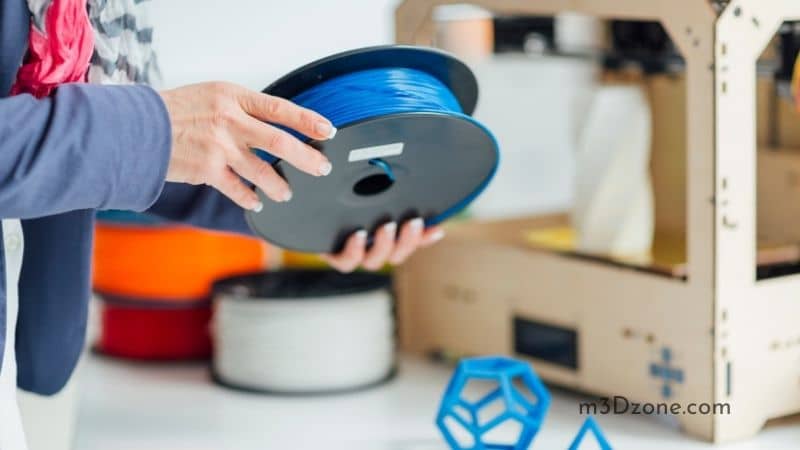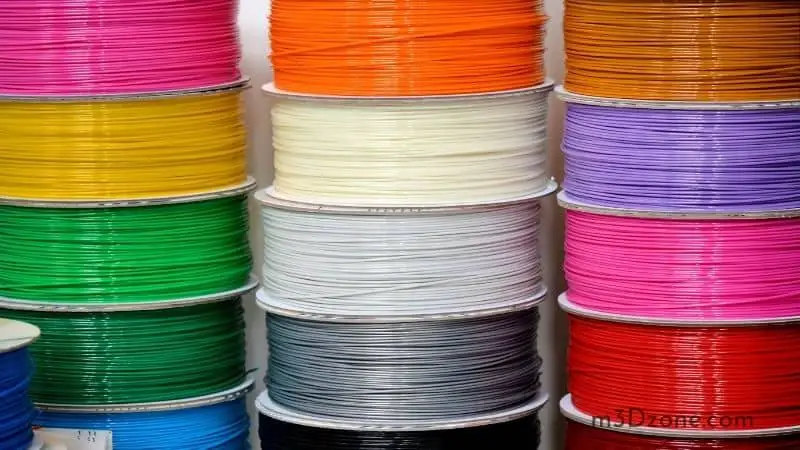Are you worried about using too much or too little filament to make your 3D print? You have just gotten a 3D painting gig. The problem is, you have no idea how much filament you will need to buy.

Each printing job has its unique amount of 3D printing filament needs. Typically, larger 3D figures consume more printing filament than smaller 3D models. The type or brand of printer you are using also determines how much filament you will use. With that in mind, if you have average 3D printing needs, 1KG of filament in a month is enough.
Quick Navigation
You want to make a quality 3D print using the least amount of printing filament possible. Yet if you don’t have the right information, you may end up losing a client due to poor 3D print quality.
To avoid making uncalled-for mistakes in the future, read through this comprehensive guide on 3D printer filament usage.
How Much Material Does a 3D Printer Use?
3D printers use materials that vary depending on how you use the printer. Therefore, you will not be able to know much material you will need by having a look at the STL or CAD file. For this reason, you first need to consider your print settings.
Look at this situation from this angle; you have set your settings to 100%. There is a certain amount of material that will be consumed. Now set the same 3D printer at 10%. You will realize that the 100% print settings consume more printing material than the 10% print settings.
The second and most effective way of determining the amount of printing material your 3D printing device uses is by loading the 3D model into a slicer. Be sure to set the slicer to optimum settings depending on the print material you are using.
Most people who have modern slicers will see the amount of material it projects to use in completing your 3D design displayed. Some slicers indicate the usage in grams while others use meters. Other slicers will even display the price if you had earlier shown the cost per KG of filament.
You can always convert these usage displays to either grams or meters, depending on your preference if you know the material’s density.
You might like: Can You Use 3D Printer Filament in a 3D Pen?
How Long Does 3D Filament Last?
How long your printing filament will last depends on a list of factors, including how many 3D models you make. If you print more 3D objects in a day, it means your filament will get depleted faster than that of everyone who prints fewer items.
For instance, if you need to make one 3D-printed chess piece for a game per day, your PLA filament will last longer than a manufacturer who produces ten chess pieces in a day.

Similarly, an individual who creates 1000 chess pieces in a week will deplete their filament roll faster than those who print 500 chess pieces in a week. Here, all chess pieces stand in for objects of a uniform size.
Looking at the same scenario, you have to print two chess pieces per day. The only changing factor here is the size of these custom-made chess pieces. If you are to print bigger cheese pieces than normal, your filament roll will last a shorter duration. This is compared to printing the same number of smaller chess pieces within the same time frame.
Another important factor that determines how long your roll lasts is your frequency of making 3D-printed items. If you are an artist who makes 3D prints often, one spool of filament will only print for a few days. A similar size spool will last months for individuals who rarely make 3D prints on the same note.
The rate at which ABS plastic filament, or any other filament, flows out through your 3D printer nozzle determines how long the filament will last. With a nozzle that extrudes more filament, you will make 3D objects with thicker layers. As a result, you will use more filament, meaning you will need to replace it often.
How Many Things Can I Print With 1 Kg Spool of Filament?
Making quality 3D prints calls for the use of calibration cubes. Now, if you have a 1KG roll of 3D printer filament, fine-tune your printer’s settings by dividing the model into calibration cubes. Doing so will give you a better perspective of the infill percentage you are dealing with.
If it’s about 5% infill, be ready to develop around three hundred calibration cubes. However, if you have to fill 100% infill, 1 KG roll of 3D printer filament will help you make 85 perfect calibration cubes.
Some people look at these calculations by using a chess piece as their subject. If you are making a chess piece of the regular size, a 1 kg roll of ABS or PLA plastic filament is enough for 350 to 450 chess pieces.
The amount of filament you are using on each chess piece will determine whether you will make 400 pieces with one KG roll or more.
How Much Filament Is on a One Kg Spool?
If you are not aware of how much filament there is in the one KG roll you buy, you may not complete your projects. This is because you may overestimate the material in one kilogram and end up with less material than needed to complete a 3D model.
People use different methods to measure the amount of filament in a one KG spool. No matter what method you use, you have to understand the types of filaments you are using. Some of us use plastic while others use other materials such as metal.
Notably, the weight of these filaments is not similar. There will be a considerable difference between the weight of plastic filament and the weight of metallic filament. Further, with different metal types, there is a weight difference.
The weight of aluminum is different from the weight of steel. So, always have this information in mind to determine how much material you will get from the rolls you buy.
How to Lower Your 3d Printer Filament Usage
If you have been depleting your filament rolls faster than estimated, you need to do something about your 3D printing approach. Here are insights on how to minimize your usage:
-
Print 3D Models of Smaller Sizes
If you want to reduce the cost of making 3D prints and the amount of filament simultaneously, you must reduce your prints’ size where possible. Some 3D objects have a definite size that has to be met to reduce the size of these. Nonetheless, if you are making an original design, it will save you some money if you print it in a smaller size.
Ask yourself this question whenever you decide on print size. Does it have to be bigger than normal? Bigger doesn’t have to be better in 3D Printing. You may compromise a design by printing a bigger object that emphasizes some aspects that were better kept small.
-
Work With Optimal Print Settings
Whenever you are using unfavorable settings, you are bound to make mistakes. For this reason, you will keep rectifying the mistake and using more filament in the process. To avoid such problems, it would be best to ensure you have optimal print settings before producing any 3D objects.
Set your slicer software in a manner that gives you the best quality prints. Also, be sure to enter appropriate settings according to the type of filament you are using. These settings include speed settings and temperature settings. You will save a lot of filament instead of reconstructing an object created using the wrong settings.
-
Create Hollow 3D Models
Whenever it is not mandatory to create an entirely solid object, always go for open items that save filaments. Such models have the desired shape and all physical characteristics. The hollow part does not compromise the quality of your 3D model.
If you are not sure whether it is good to hollow your model, you are free to do 3D scanning using your PC. You will get a better insight into the appearance and shape of the object. Use the information you collect through 3D scanning to decide the best way to have an empty space in the object.
When you doubt a hollow object’s stability, use carbon fiber printing to the PLA filament’s strength. Carbon fiber will boost the filament’s strength and improve other properties such as bed adhesion thereby reducing the intervals of buying filament spools.
-
Avoid Using 100% 3D Printed Parts
Something else you can do is avoid using 100% 3D printed parts to make your objects. It is better to mix up the parts, use a 3D printed part in one end and another part made using other manufacturing methods.
When a client hasn’t instructed you to produce a prototype using pure 3D printing, include other manufacturing processes.
This way you will reduce the amount of PETG or PLA filament roll you use to make one object. In the long run, your 3D printing activities will involve you buying fewer filament spools.
Related: 3D Printing vs Injection Molding
Conclusion
The question of how much filament you need in 3D printing depends on the factors we have discussed in this article. Most people who print more objects in a given time frame use more filament than those who make fewer 3D prints in the same duration.
Be sure to consider some other things, such as your 3D prints’ sizes and how frequently you use your 3D printers.
Recommended Reading
How to Dry PETG Filament?
How to dry PETG? To dry your PETG plastic filament, you need to put it in a convection oven or a dehydrator. Follow the instructions in this article.
Are 3D Printer Nozzles Interchangeable?
Are 3D printer nozzles interchangeable? Nowadays, 3D printers support interchangeable nozzles. But, 3D printing nozzles aren't universal.
Can You 3D Print Rubber? Is Rubber 3D Printing Possible?
Can you 3D print rubber? Yes. it is possible to create 3D print parts using rubber-like materials. Most rubber parts suit flexible production...
